MSc Psychology PS7011: Counselling Skills Process Report Analysis
VerifiedAdded on 2023/06/10
|21
|6865
|425
Report
AI Summary
This process report analyzes a recorded counselling session with a 21-year-old male client, Alejandro, who is struggling with social issues and homesickness in a new environment due to ethnic diversity. The report examines the counsellor's use of skills such as active listening, empathy, and reflection, focusing on specific segments of the conversation to highlight the client's concerns regarding homesickness, racism, and feelings of isolation. The analysis includes a transcript of the interaction, commentary on the counsellor's responses, and reflections on the client's verbal and non-verbal cues. The report also discusses the ethical considerations and challenges faced by the counsellor in addressing the client's issues, including the impact of cultural differences and the importance of providing appropriate support. The report aims to demonstrate the application of counselling skills and critical reflection on practice, highlighting areas for improvement in the counselling process.

Running head: PROCESS REPORT
Process report
Name of the student;
Name of the university:
Author note:
Process report
Name of the student;
Name of the university:
Author note:
Paraphrase This Document
Need a fresh take? Get an instant paraphrase of this document with our AI Paraphraser
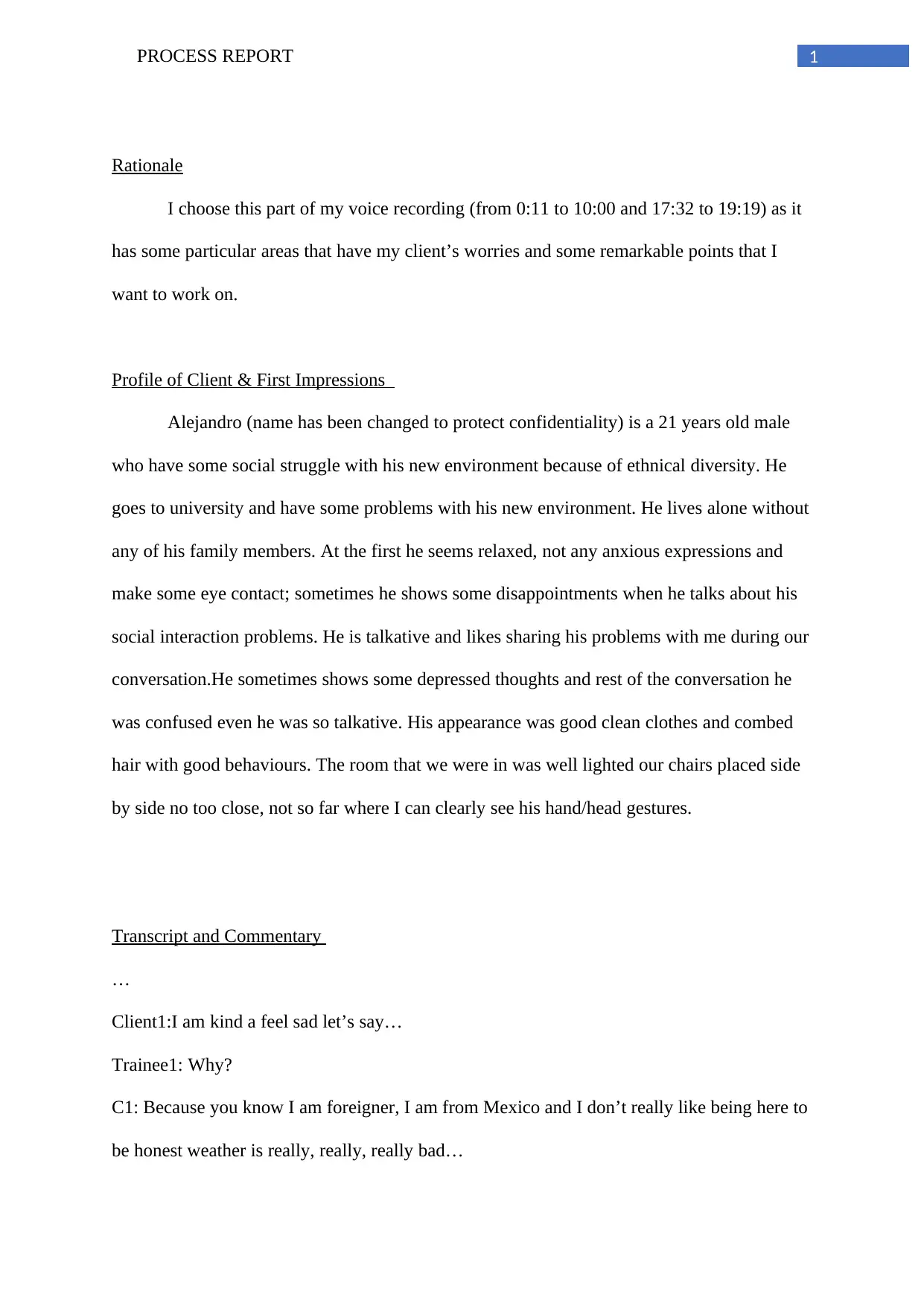
1PROCESS REPORT
Rationale
I choose this part of my voice recording (from 0:11 to 10:00 and 17:32 to 19:19) as it
has some particular areas that have my client’s worries and some remarkable points that I
want to work on.
Profile of Client & First Impressions
Alejandro (name has been changed to protect confidentiality) is a 21 years old male
who have some social struggle with his new environment because of ethnical diversity. He
goes to university and have some problems with his new environment. He lives alone without
any of his family members. At the first he seems relaxed, not any anxious expressions and
make some eye contact; sometimes he shows some disappointments when he talks about his
social interaction problems. He is talkative and likes sharing his problems with me during our
conversation.He sometimes shows some depressed thoughts and rest of the conversation he
was confused even he was so talkative. His appearance was good clean clothes and combed
hair with good behaviours. The room that we were in was well lighted our chairs placed side
by side no too close, not so far where I can clearly see his hand/head gestures.
Transcript and Commentary
…
Client1:I am kind a feel sad let’s say…
Trainee1: Why?
C1: Because you know I am foreigner, I am from Mexico and I don’t really like being here to
be honest weather is really, really, really bad…
Rationale
I choose this part of my voice recording (from 0:11 to 10:00 and 17:32 to 19:19) as it
has some particular areas that have my client’s worries and some remarkable points that I
want to work on.
Profile of Client & First Impressions
Alejandro (name has been changed to protect confidentiality) is a 21 years old male
who have some social struggle with his new environment because of ethnical diversity. He
goes to university and have some problems with his new environment. He lives alone without
any of his family members. At the first he seems relaxed, not any anxious expressions and
make some eye contact; sometimes he shows some disappointments when he talks about his
social interaction problems. He is talkative and likes sharing his problems with me during our
conversation.He sometimes shows some depressed thoughts and rest of the conversation he
was confused even he was so talkative. His appearance was good clean clothes and combed
hair with good behaviours. The room that we were in was well lighted our chairs placed side
by side no too close, not so far where I can clearly see his hand/head gestures.
Transcript and Commentary
…
Client1:I am kind a feel sad let’s say…
Trainee1: Why?
C1: Because you know I am foreigner, I am from Mexico and I don’t really like being here to
be honest weather is really, really, really bad…
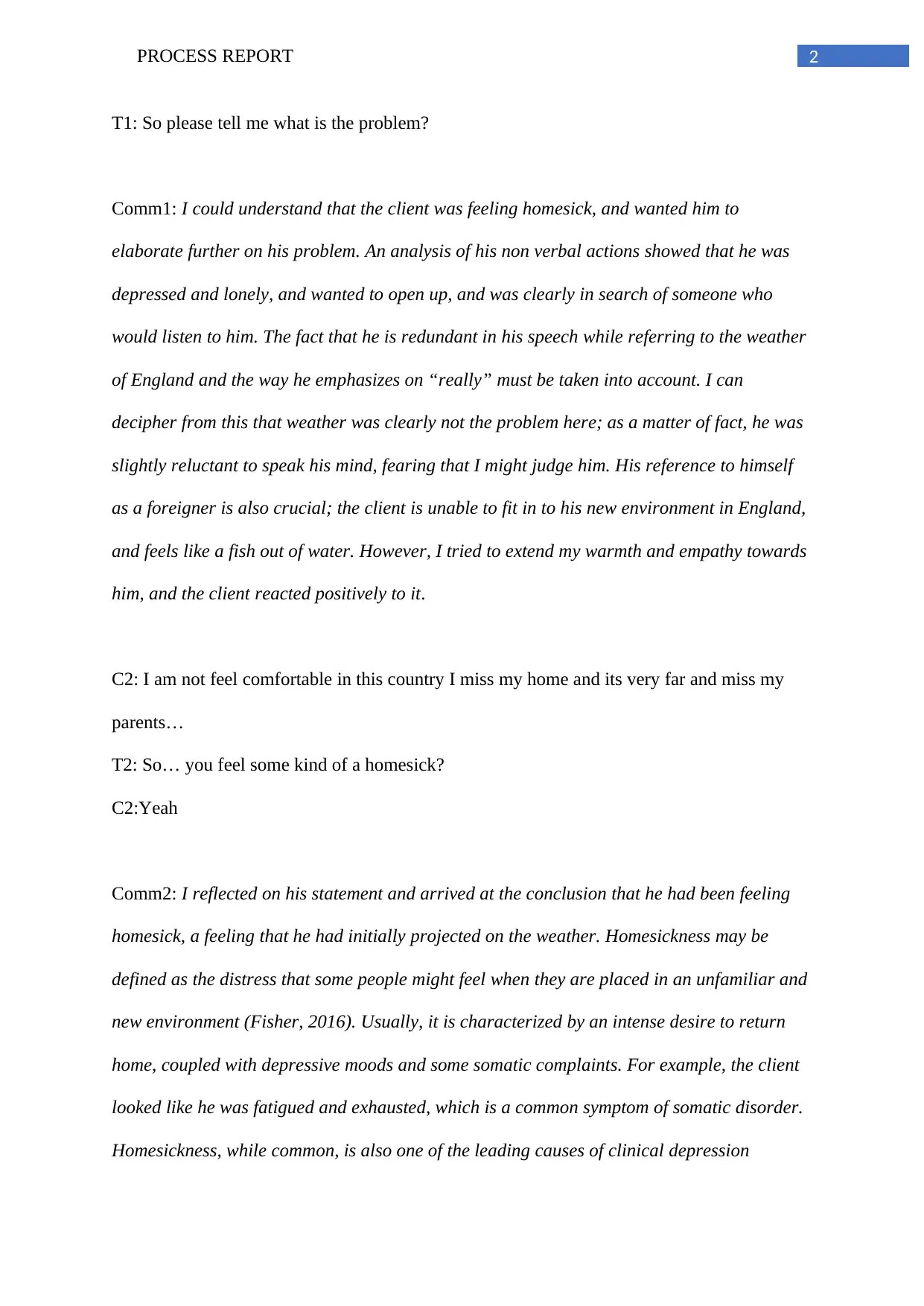
2PROCESS REPORT
T1: So please tell me what is the problem?
Comm1: I could understand that the client was feeling homesick, and wanted him to
elaborate further on his problem. An analysis of his non verbal actions showed that he was
depressed and lonely, and wanted to open up, and was clearly in search of someone who
would listen to him. The fact that he is redundant in his speech while referring to the weather
of England and the way he emphasizes on “really” must be taken into account. I can
decipher from this that weather was clearly not the problem here; as a matter of fact, he was
slightly reluctant to speak his mind, fearing that I might judge him. His reference to himself
as a foreigner is also crucial; the client is unable to fit in to his new environment in England,
and feels like a fish out of water. However, I tried to extend my warmth and empathy towards
him, and the client reacted positively to it.
C2: I am not feel comfortable in this country I miss my home and its very far and miss my
parents…
T2: So… you feel some kind of a homesick?
C2:Yeah
Comm2: I reflected on his statement and arrived at the conclusion that he had been feeling
homesick, a feeling that he had initially projected on the weather. Homesickness may be
defined as the distress that some people might feel when they are placed in an unfamiliar and
new environment (Fisher, 2016). Usually, it is characterized by an intense desire to return
home, coupled with depressive moods and some somatic complaints. For example, the client
looked like he was fatigued and exhausted, which is a common symptom of somatic disorder.
Homesickness, while common, is also one of the leading causes of clinical depression
T1: So please tell me what is the problem?
Comm1: I could understand that the client was feeling homesick, and wanted him to
elaborate further on his problem. An analysis of his non verbal actions showed that he was
depressed and lonely, and wanted to open up, and was clearly in search of someone who
would listen to him. The fact that he is redundant in his speech while referring to the weather
of England and the way he emphasizes on “really” must be taken into account. I can
decipher from this that weather was clearly not the problem here; as a matter of fact, he was
slightly reluctant to speak his mind, fearing that I might judge him. His reference to himself
as a foreigner is also crucial; the client is unable to fit in to his new environment in England,
and feels like a fish out of water. However, I tried to extend my warmth and empathy towards
him, and the client reacted positively to it.
C2: I am not feel comfortable in this country I miss my home and its very far and miss my
parents…
T2: So… you feel some kind of a homesick?
C2:Yeah
Comm2: I reflected on his statement and arrived at the conclusion that he had been feeling
homesick, a feeling that he had initially projected on the weather. Homesickness may be
defined as the distress that some people might feel when they are placed in an unfamiliar and
new environment (Fisher, 2016). Usually, it is characterized by an intense desire to return
home, coupled with depressive moods and some somatic complaints. For example, the client
looked like he was fatigued and exhausted, which is a common symptom of somatic disorder.
Homesickness, while common, is also one of the leading causes of clinical depression
⊘ This is a preview!⊘
Do you want full access?
Subscribe today to unlock all pages.

Trusted by 1+ million students worldwide
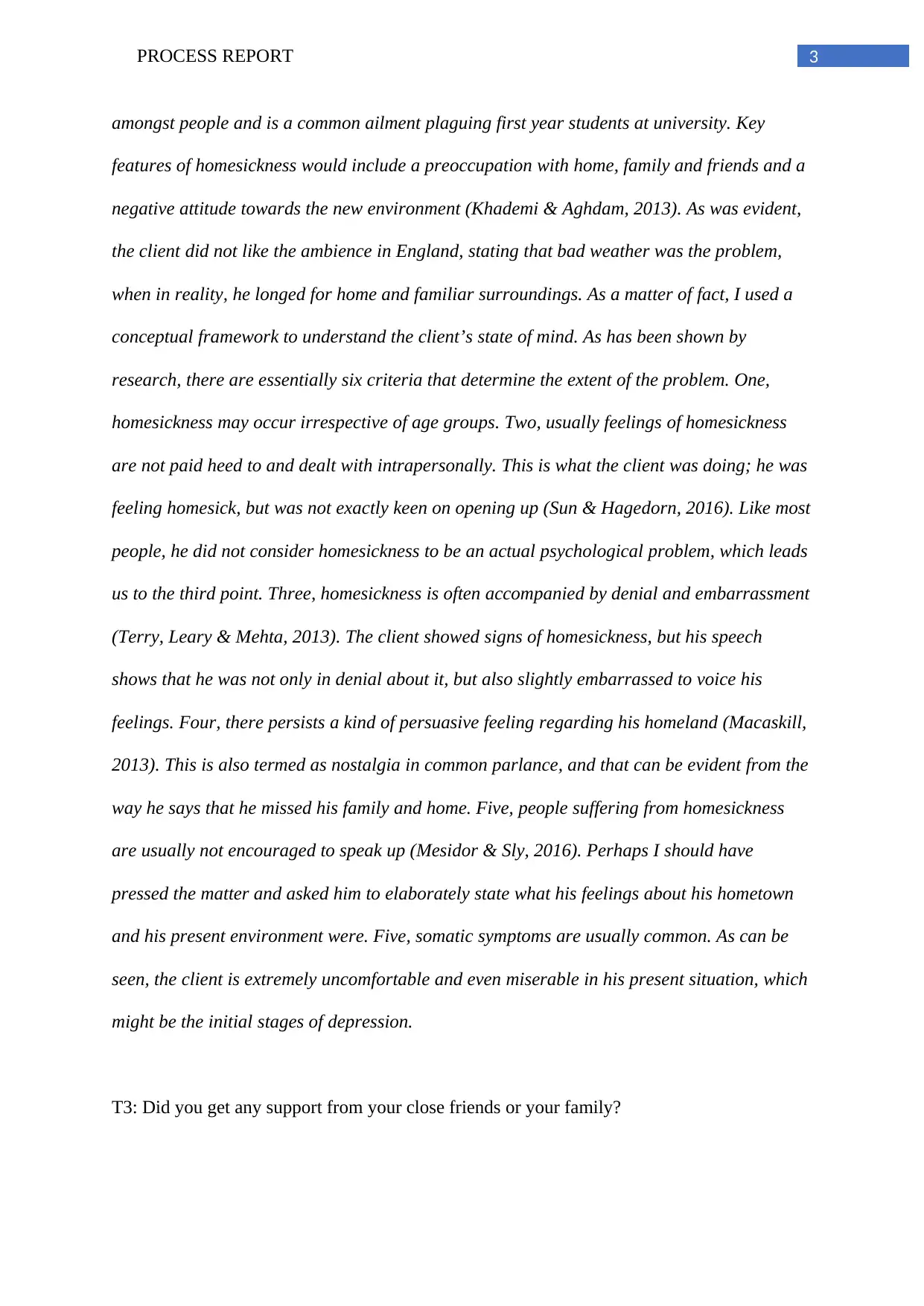
3PROCESS REPORT
amongst people and is a common ailment plaguing first year students at university. Key
features of homesickness would include a preoccupation with home, family and friends and a
negative attitude towards the new environment (Khademi & Aghdam, 2013). As was evident,
the client did not like the ambience in England, stating that bad weather was the problem,
when in reality, he longed for home and familiar surroundings. As a matter of fact, I used a
conceptual framework to understand the client’s state of mind. As has been shown by
research, there are essentially six criteria that determine the extent of the problem. One,
homesickness may occur irrespective of age groups. Two, usually feelings of homesickness
are not paid heed to and dealt with intrapersonally. This is what the client was doing; he was
feeling homesick, but was not exactly keen on opening up (Sun & Hagedorn, 2016). Like most
people, he did not consider homesickness to be an actual psychological problem, which leads
us to the third point. Three, homesickness is often accompanied by denial and embarrassment
(Terry, Leary & Mehta, 2013). The client showed signs of homesickness, but his speech
shows that he was not only in denial about it, but also slightly embarrassed to voice his
feelings. Four, there persists a kind of persuasive feeling regarding his homeland (Macaskill,
2013). This is also termed as nostalgia in common parlance, and that can be evident from the
way he says that he missed his family and home. Five, people suffering from homesickness
are usually not encouraged to speak up (Mesidor & Sly, 2016). Perhaps I should have
pressed the matter and asked him to elaborately state what his feelings about his hometown
and his present environment were. Five, somatic symptoms are usually common. As can be
seen, the client is extremely uncomfortable and even miserable in his present situation, which
might be the initial stages of depression.
T3: Did you get any support from your close friends or your family?
amongst people and is a common ailment plaguing first year students at university. Key
features of homesickness would include a preoccupation with home, family and friends and a
negative attitude towards the new environment (Khademi & Aghdam, 2013). As was evident,
the client did not like the ambience in England, stating that bad weather was the problem,
when in reality, he longed for home and familiar surroundings. As a matter of fact, I used a
conceptual framework to understand the client’s state of mind. As has been shown by
research, there are essentially six criteria that determine the extent of the problem. One,
homesickness may occur irrespective of age groups. Two, usually feelings of homesickness
are not paid heed to and dealt with intrapersonally. This is what the client was doing; he was
feeling homesick, but was not exactly keen on opening up (Sun & Hagedorn, 2016). Like most
people, he did not consider homesickness to be an actual psychological problem, which leads
us to the third point. Three, homesickness is often accompanied by denial and embarrassment
(Terry, Leary & Mehta, 2013). The client showed signs of homesickness, but his speech
shows that he was not only in denial about it, but also slightly embarrassed to voice his
feelings. Four, there persists a kind of persuasive feeling regarding his homeland (Macaskill,
2013). This is also termed as nostalgia in common parlance, and that can be evident from the
way he says that he missed his family and home. Five, people suffering from homesickness
are usually not encouraged to speak up (Mesidor & Sly, 2016). Perhaps I should have
pressed the matter and asked him to elaborately state what his feelings about his hometown
and his present environment were. Five, somatic symptoms are usually common. As can be
seen, the client is extremely uncomfortable and even miserable in his present situation, which
might be the initial stages of depression.
T3: Did you get any support from your close friends or your family?
Paraphrase This Document
Need a fresh take? Get an instant paraphrase of this document with our AI Paraphraser
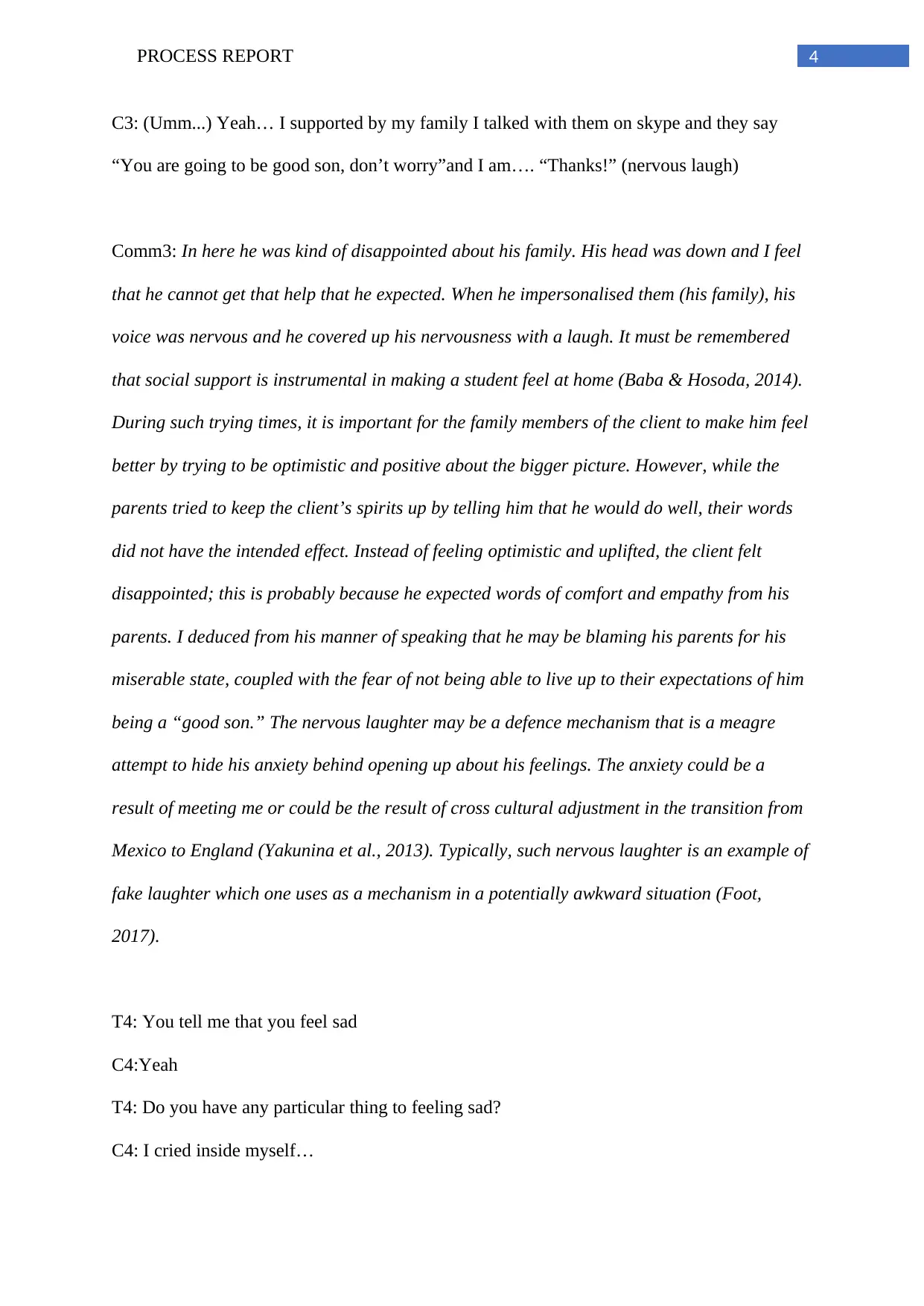
4PROCESS REPORT
C3: (Umm...) Yeah… I supported by my family I talked with them on skype and they say
“You are going to be good son, don’t worry”and I am…. “Thanks!” (nervous laugh)
Comm3: In here he was kind of disappointed about his family. His head was down and I feel
that he cannot get that help that he expected. When he impersonalised them (his family), his
voice was nervous and he covered up his nervousness with a laugh. It must be remembered
that social support is instrumental in making a student feel at home (Baba & Hosoda, 2014).
During such trying times, it is important for the family members of the client to make him feel
better by trying to be optimistic and positive about the bigger picture. However, while the
parents tried to keep the client’s spirits up by telling him that he would do well, their words
did not have the intended effect. Instead of feeling optimistic and uplifted, the client felt
disappointed; this is probably because he expected words of comfort and empathy from his
parents. I deduced from his manner of speaking that he may be blaming his parents for his
miserable state, coupled with the fear of not being able to live up to their expectations of him
being a “good son.” The nervous laughter may be a defence mechanism that is a meagre
attempt to hide his anxiety behind opening up about his feelings. The anxiety could be a
result of meeting me or could be the result of cross cultural adjustment in the transition from
Mexico to England (Yakunina et al., 2013). Typically, such nervous laughter is an example of
fake laughter which one uses as a mechanism in a potentially awkward situation (Foot,
2017).
T4: You tell me that you feel sad
C4:Yeah
T4: Do you have any particular thing to feeling sad?
C4: I cried inside myself…
C3: (Umm...) Yeah… I supported by my family I talked with them on skype and they say
“You are going to be good son, don’t worry”and I am…. “Thanks!” (nervous laugh)
Comm3: In here he was kind of disappointed about his family. His head was down and I feel
that he cannot get that help that he expected. When he impersonalised them (his family), his
voice was nervous and he covered up his nervousness with a laugh. It must be remembered
that social support is instrumental in making a student feel at home (Baba & Hosoda, 2014).
During such trying times, it is important for the family members of the client to make him feel
better by trying to be optimistic and positive about the bigger picture. However, while the
parents tried to keep the client’s spirits up by telling him that he would do well, their words
did not have the intended effect. Instead of feeling optimistic and uplifted, the client felt
disappointed; this is probably because he expected words of comfort and empathy from his
parents. I deduced from his manner of speaking that he may be blaming his parents for his
miserable state, coupled with the fear of not being able to live up to their expectations of him
being a “good son.” The nervous laughter may be a defence mechanism that is a meagre
attempt to hide his anxiety behind opening up about his feelings. The anxiety could be a
result of meeting me or could be the result of cross cultural adjustment in the transition from
Mexico to England (Yakunina et al., 2013). Typically, such nervous laughter is an example of
fake laughter which one uses as a mechanism in a potentially awkward situation (Foot,
2017).
T4: You tell me that you feel sad
C4:Yeah
T4: Do you have any particular thing to feeling sad?
C4: I cried inside myself…
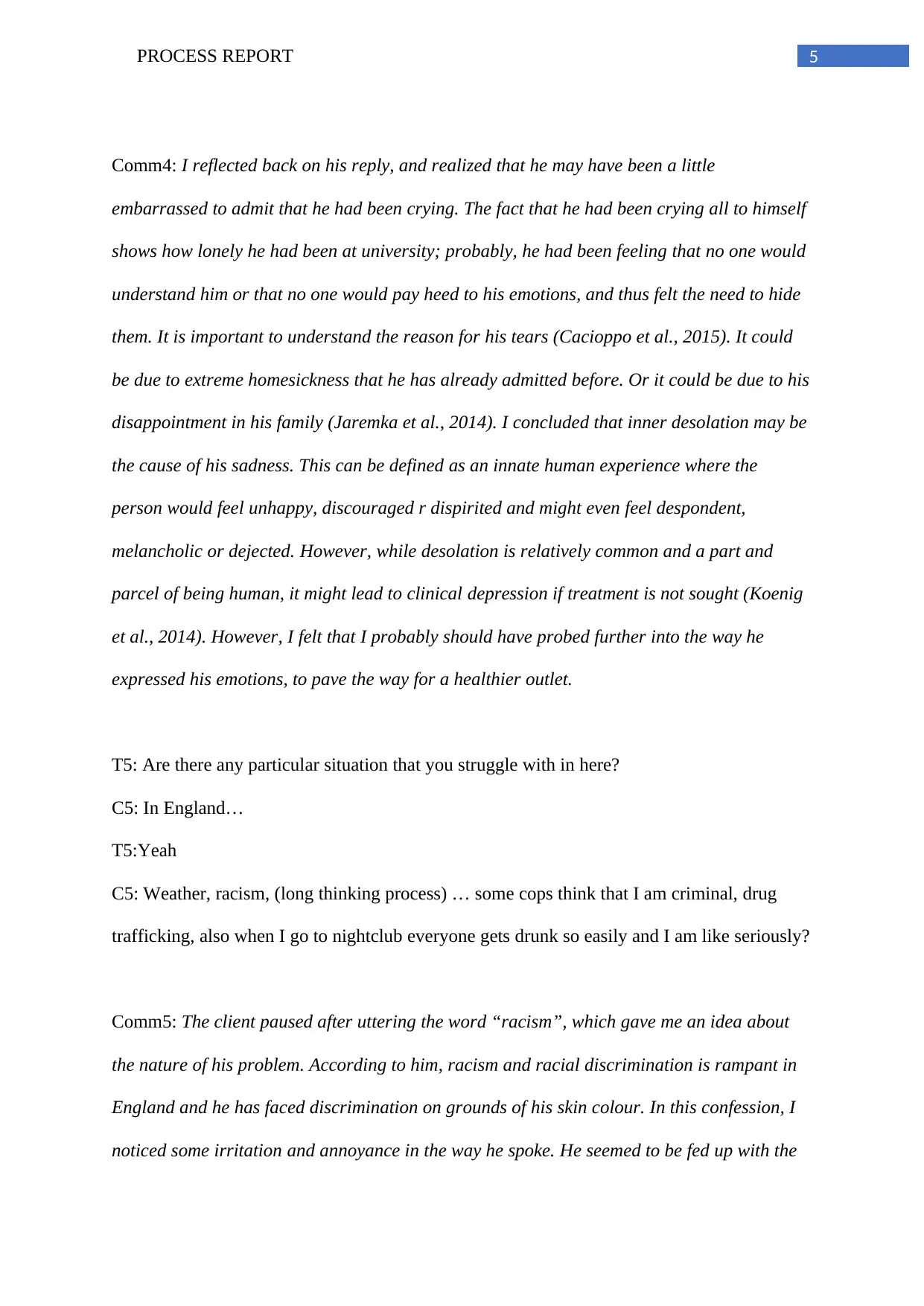
5PROCESS REPORT
Comm4: I reflected back on his reply, and realized that he may have been a little
embarrassed to admit that he had been crying. The fact that he had been crying all to himself
shows how lonely he had been at university; probably, he had been feeling that no one would
understand him or that no one would pay heed to his emotions, and thus felt the need to hide
them. It is important to understand the reason for his tears (Cacioppo et al., 2015). It could
be due to extreme homesickness that he has already admitted before. Or it could be due to his
disappointment in his family (Jaremka et al., 2014). I concluded that inner desolation may be
the cause of his sadness. This can be defined as an innate human experience where the
person would feel unhappy, discouraged r dispirited and might even feel despondent,
melancholic or dejected. However, while desolation is relatively common and a part and
parcel of being human, it might lead to clinical depression if treatment is not sought (Koenig
et al., 2014). However, I felt that I probably should have probed further into the way he
expressed his emotions, to pave the way for a healthier outlet.
T5: Are there any particular situation that you struggle with in here?
C5: In England…
T5:Yeah
C5: Weather, racism, (long thinking process) … some cops think that I am criminal, drug
trafficking, also when I go to nightclub everyone gets drunk so easily and I am like seriously?
Comm5: The client paused after uttering the word “racism”, which gave me an idea about
the nature of his problem. According to him, racism and racial discrimination is rampant in
England and he has faced discrimination on grounds of his skin colour. In this confession, I
noticed some irritation and annoyance in the way he spoke. He seemed to be fed up with the
Comm4: I reflected back on his reply, and realized that he may have been a little
embarrassed to admit that he had been crying. The fact that he had been crying all to himself
shows how lonely he had been at university; probably, he had been feeling that no one would
understand him or that no one would pay heed to his emotions, and thus felt the need to hide
them. It is important to understand the reason for his tears (Cacioppo et al., 2015). It could
be due to extreme homesickness that he has already admitted before. Or it could be due to his
disappointment in his family (Jaremka et al., 2014). I concluded that inner desolation may be
the cause of his sadness. This can be defined as an innate human experience where the
person would feel unhappy, discouraged r dispirited and might even feel despondent,
melancholic or dejected. However, while desolation is relatively common and a part and
parcel of being human, it might lead to clinical depression if treatment is not sought (Koenig
et al., 2014). However, I felt that I probably should have probed further into the way he
expressed his emotions, to pave the way for a healthier outlet.
T5: Are there any particular situation that you struggle with in here?
C5: In England…
T5:Yeah
C5: Weather, racism, (long thinking process) … some cops think that I am criminal, drug
trafficking, also when I go to nightclub everyone gets drunk so easily and I am like seriously?
Comm5: The client paused after uttering the word “racism”, which gave me an idea about
the nature of his problem. According to him, racism and racial discrimination is rampant in
England and he has faced discrimination on grounds of his skin colour. In this confession, I
noticed some irritation and annoyance in the way he spoke. He seemed to be fed up with the
⊘ This is a preview!⊘
Do you want full access?
Subscribe today to unlock all pages.

Trusted by 1+ million students worldwide
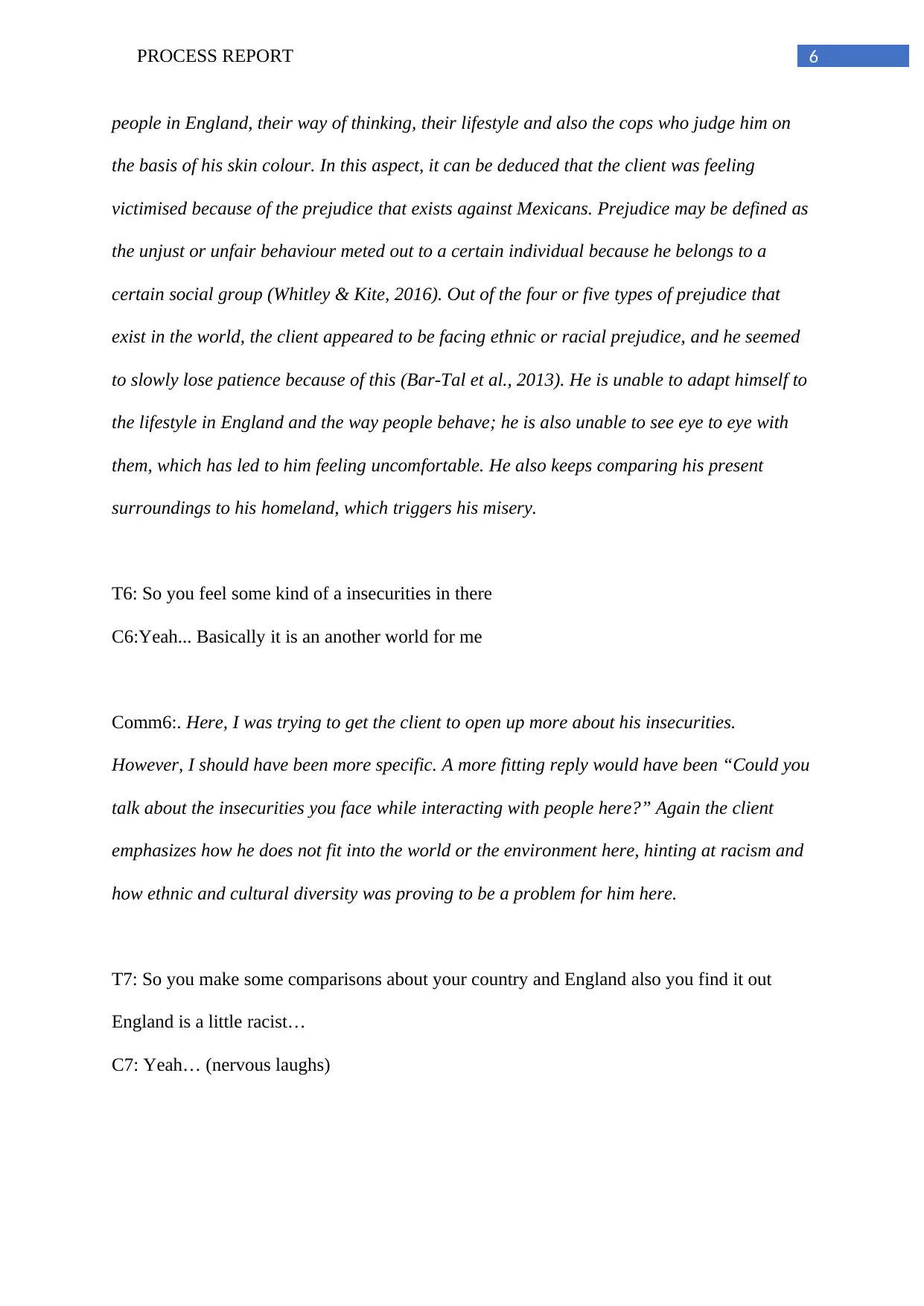
6PROCESS REPORT
people in England, their way of thinking, their lifestyle and also the cops who judge him on
the basis of his skin colour. In this aspect, it can be deduced that the client was feeling
victimised because of the prejudice that exists against Mexicans. Prejudice may be defined as
the unjust or unfair behaviour meted out to a certain individual because he belongs to a
certain social group (Whitley & Kite, 2016). Out of the four or five types of prejudice that
exist in the world, the client appeared to be facing ethnic or racial prejudice, and he seemed
to slowly lose patience because of this (Bar-Tal et al., 2013). He is unable to adapt himself to
the lifestyle in England and the way people behave; he is also unable to see eye to eye with
them, which has led to him feeling uncomfortable. He also keeps comparing his present
surroundings to his homeland, which triggers his misery.
T6: So you feel some kind of a insecurities in there
C6:Yeah... Basically it is an another world for me
Comm6:. Here, I was trying to get the client to open up more about his insecurities.
However, I should have been more specific. A more fitting reply would have been “Could you
talk about the insecurities you face while interacting with people here?” Again the client
emphasizes how he does not fit into the world or the environment here, hinting at racism and
how ethnic and cultural diversity was proving to be a problem for him here.
T7: So you make some comparisons about your country and England also you find it out
England is a little racist…
C7: Yeah… (nervous laughs)
people in England, their way of thinking, their lifestyle and also the cops who judge him on
the basis of his skin colour. In this aspect, it can be deduced that the client was feeling
victimised because of the prejudice that exists against Mexicans. Prejudice may be defined as
the unjust or unfair behaviour meted out to a certain individual because he belongs to a
certain social group (Whitley & Kite, 2016). Out of the four or five types of prejudice that
exist in the world, the client appeared to be facing ethnic or racial prejudice, and he seemed
to slowly lose patience because of this (Bar-Tal et al., 2013). He is unable to adapt himself to
the lifestyle in England and the way people behave; he is also unable to see eye to eye with
them, which has led to him feeling uncomfortable. He also keeps comparing his present
surroundings to his homeland, which triggers his misery.
T6: So you feel some kind of a insecurities in there
C6:Yeah... Basically it is an another world for me
Comm6:. Here, I was trying to get the client to open up more about his insecurities.
However, I should have been more specific. A more fitting reply would have been “Could you
talk about the insecurities you face while interacting with people here?” Again the client
emphasizes how he does not fit into the world or the environment here, hinting at racism and
how ethnic and cultural diversity was proving to be a problem for him here.
T7: So you make some comparisons about your country and England also you find it out
England is a little racist…
C7: Yeah… (nervous laughs)
Paraphrase This Document
Need a fresh take? Get an instant paraphrase of this document with our AI Paraphraser

7PROCESS REPORT
Comm7: The nervous laughter again shows a degree of uncertainty and insecurity in the
client (Gregory, 2013). The purpose of my statement was to instigate him to elaborate on his
problem. However, his monosyllabic reply here has a different connotation; he was probably
fearing judgement from me and was unsure as to what my stand would be on ethnic diversity
and racism in England.
T8: So you don’t have anything in your country like this… Any racism, any drunk people
or... (hecut off my sentence), drugs…
C8: I am going to talk about it of course we had the bad sides; and of course there is a racism
in my country but something for the “gringos” aka. I think everyone knows what “gringo”
means… I try to explain the “gringo” means
Comm8: I reflected back on this exchange and could understand that the client was
beginning to get a little defensive. He may have wrongly assumed that I did not believe in his
suffering or misery caused by racial discrimination. On reflection, it may have been my fault;
the fact that I hinted at the racism in his country might have triggered some suppressed
anger. Defensiveness may be defined as the psychological response which is a direct result of
an imagined or perceived threat to one’s sense of self, which in this case is directly linked to
his homeland (Hart, 2015). The client becomes shifty and agitated and cuts me off before I
could complete my sentence. This is known as defence mechanism (Freud, 2014). This may be
his defence mechanism against the preconceived notions about his homeland; there are
common perceptions that Mexico is steeped in crime and drugs, which might be the
foundation for racism and ethnic discrimination in England. Reference to that may have
brought out a need to defend his homeland or his country. That is why he also refers to the
Comm7: The nervous laughter again shows a degree of uncertainty and insecurity in the
client (Gregory, 2013). The purpose of my statement was to instigate him to elaborate on his
problem. However, his monosyllabic reply here has a different connotation; he was probably
fearing judgement from me and was unsure as to what my stand would be on ethnic diversity
and racism in England.
T8: So you don’t have anything in your country like this… Any racism, any drunk people
or... (hecut off my sentence), drugs…
C8: I am going to talk about it of course we had the bad sides; and of course there is a racism
in my country but something for the “gringos” aka. I think everyone knows what “gringo”
means… I try to explain the “gringo” means
Comm8: I reflected back on this exchange and could understand that the client was
beginning to get a little defensive. He may have wrongly assumed that I did not believe in his
suffering or misery caused by racial discrimination. On reflection, it may have been my fault;
the fact that I hinted at the racism in his country might have triggered some suppressed
anger. Defensiveness may be defined as the psychological response which is a direct result of
an imagined or perceived threat to one’s sense of self, which in this case is directly linked to
his homeland (Hart, 2015). The client becomes shifty and agitated and cuts me off before I
could complete my sentence. This is known as defence mechanism (Freud, 2014). This may be
his defence mechanism against the preconceived notions about his homeland; there are
common perceptions that Mexico is steeped in crime and drugs, which might be the
foundation for racism and ethnic discrimination in England. Reference to that may have
brought out a need to defend his homeland or his country. That is why he also refers to the
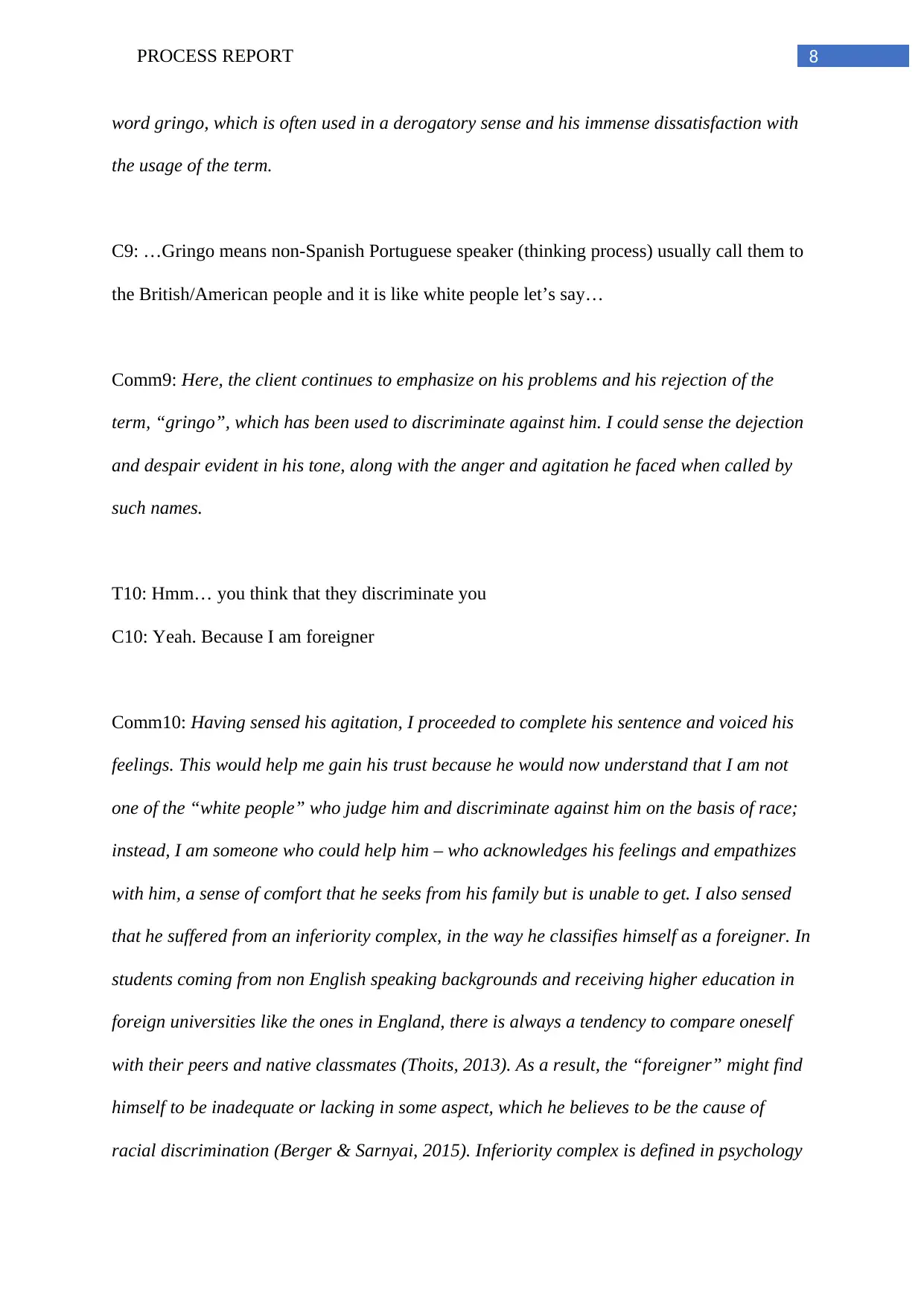
8PROCESS REPORT
word gringo, which is often used in a derogatory sense and his immense dissatisfaction with
the usage of the term.
C9: …Gringo means non-Spanish Portuguese speaker (thinking process) usually call them to
the British/American people and it is like white people let’s say…
Comm9: Here, the client continues to emphasize on his problems and his rejection of the
term, “gringo”, which has been used to discriminate against him. I could sense the dejection
and despair evident in his tone, along with the anger and agitation he faced when called by
such names.
T10: Hmm… you think that they discriminate you
C10: Yeah. Because I am foreigner
Comm10: Having sensed his agitation, I proceeded to complete his sentence and voiced his
feelings. This would help me gain his trust because he would now understand that I am not
one of the “white people” who judge him and discriminate against him on the basis of race;
instead, I am someone who could help him – who acknowledges his feelings and empathizes
with him, a sense of comfort that he seeks from his family but is unable to get. I also sensed
that he suffered from an inferiority complex, in the way he classifies himself as a foreigner. In
students coming from non English speaking backgrounds and receiving higher education in
foreign universities like the ones in England, there is always a tendency to compare oneself
with their peers and native classmates (Thoits, 2013). As a result, the “foreigner” might find
himself to be inadequate or lacking in some aspect, which he believes to be the cause of
racial discrimination (Berger & Sarnyai, 2015). Inferiority complex is defined in psychology
word gringo, which is often used in a derogatory sense and his immense dissatisfaction with
the usage of the term.
C9: …Gringo means non-Spanish Portuguese speaker (thinking process) usually call them to
the British/American people and it is like white people let’s say…
Comm9: Here, the client continues to emphasize on his problems and his rejection of the
term, “gringo”, which has been used to discriminate against him. I could sense the dejection
and despair evident in his tone, along with the anger and agitation he faced when called by
such names.
T10: Hmm… you think that they discriminate you
C10: Yeah. Because I am foreigner
Comm10: Having sensed his agitation, I proceeded to complete his sentence and voiced his
feelings. This would help me gain his trust because he would now understand that I am not
one of the “white people” who judge him and discriminate against him on the basis of race;
instead, I am someone who could help him – who acknowledges his feelings and empathizes
with him, a sense of comfort that he seeks from his family but is unable to get. I also sensed
that he suffered from an inferiority complex, in the way he classifies himself as a foreigner. In
students coming from non English speaking backgrounds and receiving higher education in
foreign universities like the ones in England, there is always a tendency to compare oneself
with their peers and native classmates (Thoits, 2013). As a result, the “foreigner” might find
himself to be inadequate or lacking in some aspect, which he believes to be the cause of
racial discrimination (Berger & Sarnyai, 2015). Inferiority complex is defined in psychology
⊘ This is a preview!⊘
Do you want full access?
Subscribe today to unlock all pages.

Trusted by 1+ million students worldwide
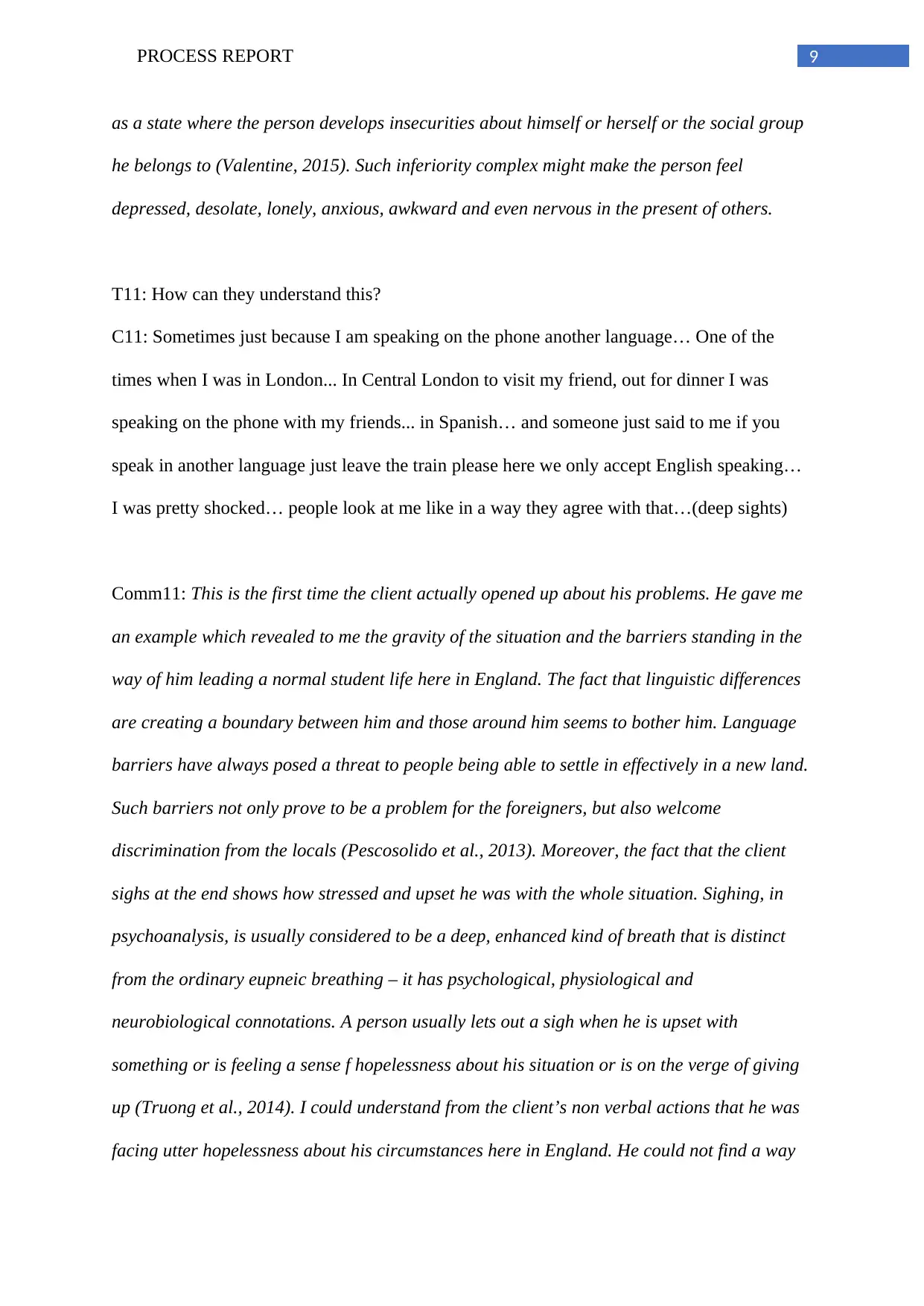
9PROCESS REPORT
as a state where the person develops insecurities about himself or herself or the social group
he belongs to (Valentine, 2015). Such inferiority complex might make the person feel
depressed, desolate, lonely, anxious, awkward and even nervous in the present of others.
T11: How can they understand this?
C11: Sometimes just because I am speaking on the phone another language… One of the
times when I was in London... In Central London to visit my friend, out for dinner I was
speaking on the phone with my friends... in Spanish… and someone just said to me if you
speak in another language just leave the train please here we only accept English speaking…
I was pretty shocked… people look at me like in a way they agree with that…(deep sights)
Comm11: This is the first time the client actually opened up about his problems. He gave me
an example which revealed to me the gravity of the situation and the barriers standing in the
way of him leading a normal student life here in England. The fact that linguistic differences
are creating a boundary between him and those around him seems to bother him. Language
barriers have always posed a threat to people being able to settle in effectively in a new land.
Such barriers not only prove to be a problem for the foreigners, but also welcome
discrimination from the locals (Pescosolido et al., 2013). Moreover, the fact that the client
sighs at the end shows how stressed and upset he was with the whole situation. Sighing, in
psychoanalysis, is usually considered to be a deep, enhanced kind of breath that is distinct
from the ordinary eupneic breathing – it has psychological, physiological and
neurobiological connotations. A person usually lets out a sigh when he is upset with
something or is feeling a sense f hopelessness about his situation or is on the verge of giving
up (Truong et al., 2014). I could understand from the client’s non verbal actions that he was
facing utter hopelessness about his circumstances here in England. He could not find a way
as a state where the person develops insecurities about himself or herself or the social group
he belongs to (Valentine, 2015). Such inferiority complex might make the person feel
depressed, desolate, lonely, anxious, awkward and even nervous in the present of others.
T11: How can they understand this?
C11: Sometimes just because I am speaking on the phone another language… One of the
times when I was in London... In Central London to visit my friend, out for dinner I was
speaking on the phone with my friends... in Spanish… and someone just said to me if you
speak in another language just leave the train please here we only accept English speaking…
I was pretty shocked… people look at me like in a way they agree with that…(deep sights)
Comm11: This is the first time the client actually opened up about his problems. He gave me
an example which revealed to me the gravity of the situation and the barriers standing in the
way of him leading a normal student life here in England. The fact that linguistic differences
are creating a boundary between him and those around him seems to bother him. Language
barriers have always posed a threat to people being able to settle in effectively in a new land.
Such barriers not only prove to be a problem for the foreigners, but also welcome
discrimination from the locals (Pescosolido et al., 2013). Moreover, the fact that the client
sighs at the end shows how stressed and upset he was with the whole situation. Sighing, in
psychoanalysis, is usually considered to be a deep, enhanced kind of breath that is distinct
from the ordinary eupneic breathing – it has psychological, physiological and
neurobiological connotations. A person usually lets out a sigh when he is upset with
something or is feeling a sense f hopelessness about his situation or is on the verge of giving
up (Truong et al., 2014). I could understand from the client’s non verbal actions that he was
facing utter hopelessness about his circumstances here in England. He could not find a way
Paraphrase This Document
Need a fresh take? Get an instant paraphrase of this document with our AI Paraphraser
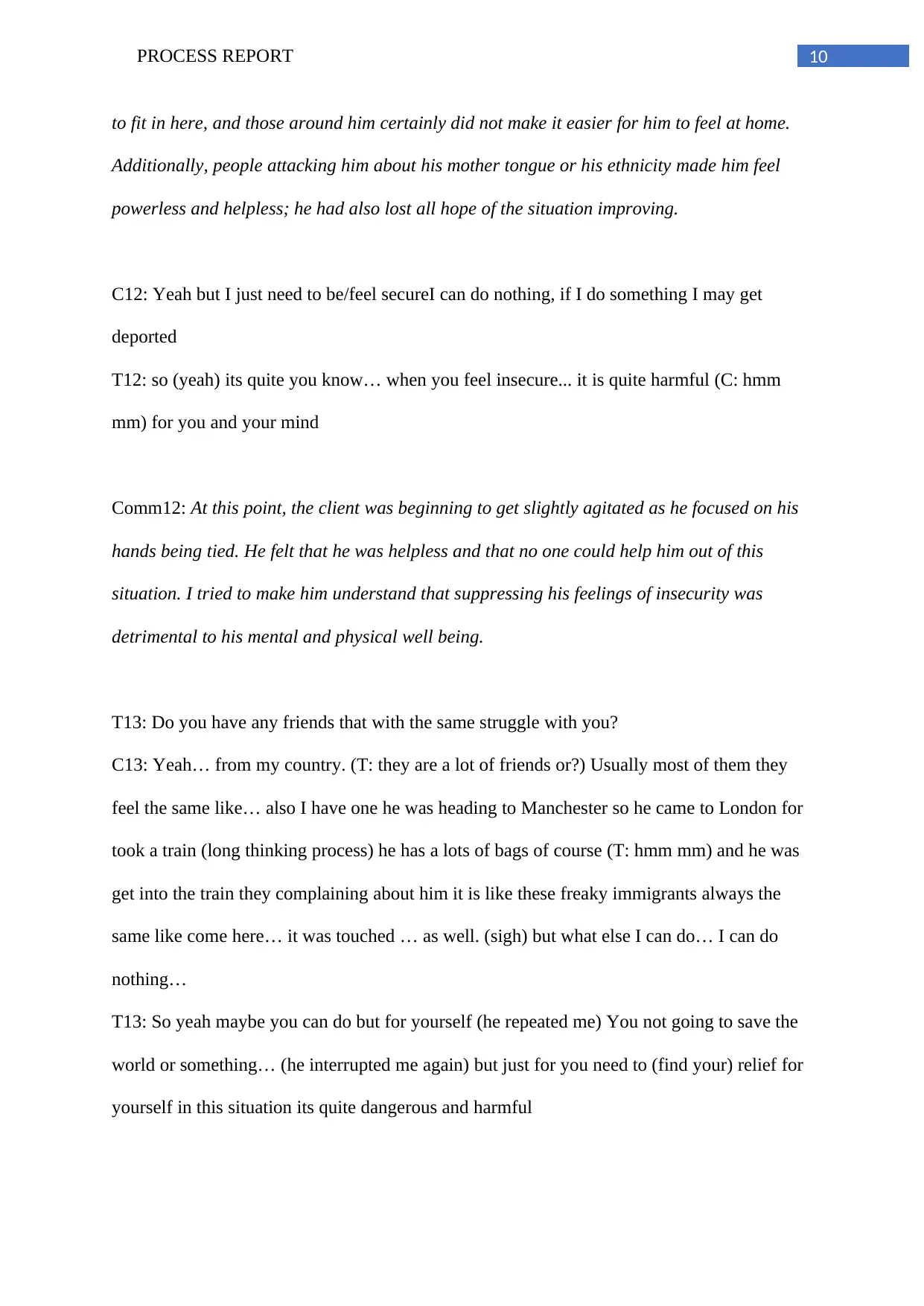
10PROCESS REPORT
to fit in here, and those around him certainly did not make it easier for him to feel at home.
Additionally, people attacking him about his mother tongue or his ethnicity made him feel
powerless and helpless; he had also lost all hope of the situation improving.
C12: Yeah but I just need to be/feel secureI can do nothing, if I do something I may get
deported
T12: so (yeah) its quite you know… when you feel insecure... it is quite harmful (C: hmm
mm) for you and your mind
Comm12: At this point, the client was beginning to get slightly agitated as he focused on his
hands being tied. He felt that he was helpless and that no one could help him out of this
situation. I tried to make him understand that suppressing his feelings of insecurity was
detrimental to his mental and physical well being.
T13: Do you have any friends that with the same struggle with you?
C13: Yeah… from my country. (T: they are a lot of friends or?) Usually most of them they
feel the same like… also I have one he was heading to Manchester so he came to London for
took a train (long thinking process) he has a lots of bags of course (T: hmm mm) and he was
get into the train they complaining about him it is like these freaky immigrants always the
same like come here… it was touched … as well. (sigh) but what else I can do… I can do
nothing…
T13: So yeah maybe you can do but for yourself (he repeated me) You not going to save the
world or something… (he interrupted me again) but just for you need to (find your) relief for
yourself in this situation its quite dangerous and harmful
to fit in here, and those around him certainly did not make it easier for him to feel at home.
Additionally, people attacking him about his mother tongue or his ethnicity made him feel
powerless and helpless; he had also lost all hope of the situation improving.
C12: Yeah but I just need to be/feel secureI can do nothing, if I do something I may get
deported
T12: so (yeah) its quite you know… when you feel insecure... it is quite harmful (C: hmm
mm) for you and your mind
Comm12: At this point, the client was beginning to get slightly agitated as he focused on his
hands being tied. He felt that he was helpless and that no one could help him out of this
situation. I tried to make him understand that suppressing his feelings of insecurity was
detrimental to his mental and physical well being.
T13: Do you have any friends that with the same struggle with you?
C13: Yeah… from my country. (T: they are a lot of friends or?) Usually most of them they
feel the same like… also I have one he was heading to Manchester so he came to London for
took a train (long thinking process) he has a lots of bags of course (T: hmm mm) and he was
get into the train they complaining about him it is like these freaky immigrants always the
same like come here… it was touched … as well. (sigh) but what else I can do… I can do
nothing…
T13: So yeah maybe you can do but for yourself (he repeated me) You not going to save the
world or something… (he interrupted me again) but just for you need to (find your) relief for
yourself in this situation its quite dangerous and harmful
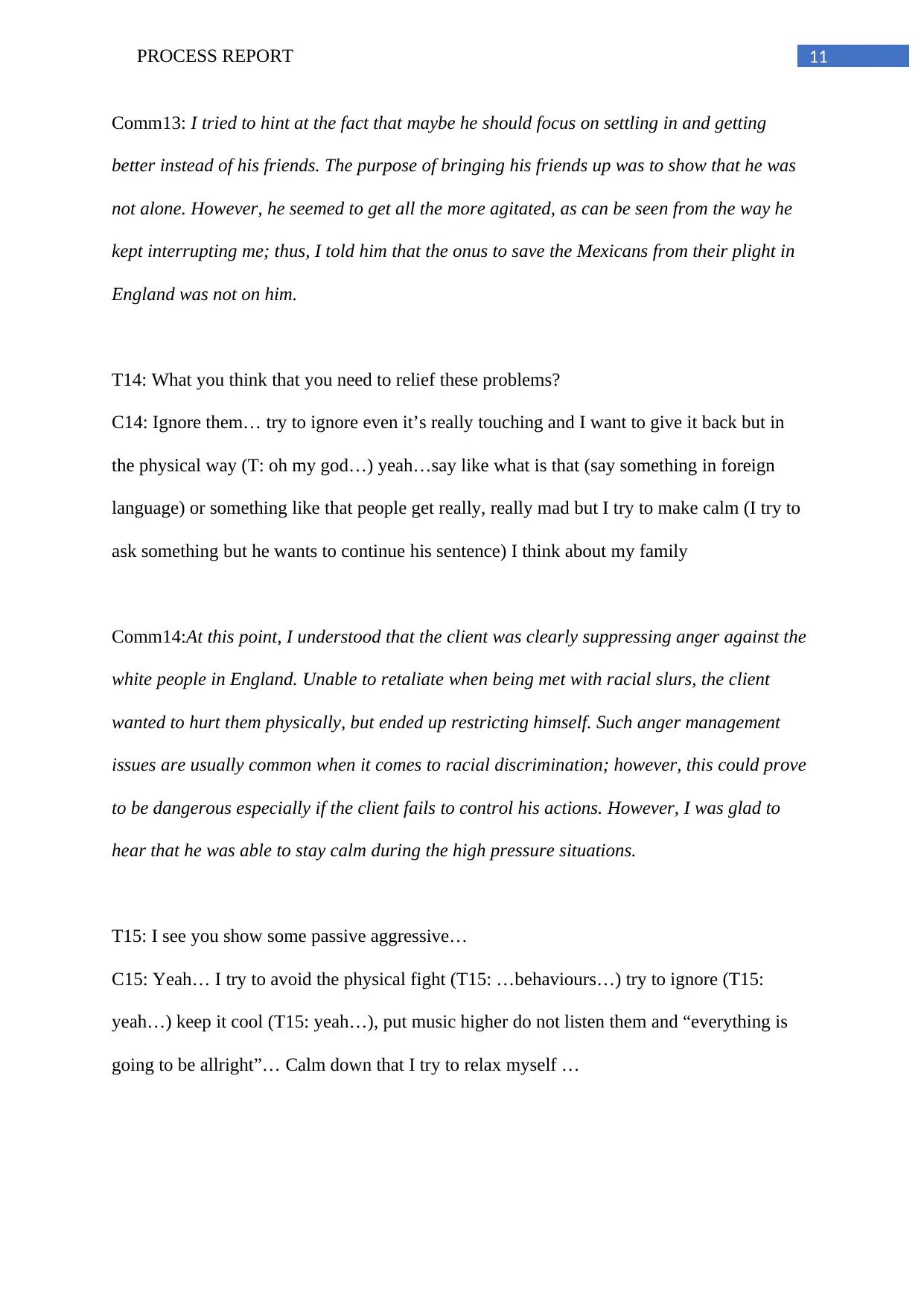
11PROCESS REPORT
Comm13: I tried to hint at the fact that maybe he should focus on settling in and getting
better instead of his friends. The purpose of bringing his friends up was to show that he was
not alone. However, he seemed to get all the more agitated, as can be seen from the way he
kept interrupting me; thus, I told him that the onus to save the Mexicans from their plight in
England was not on him.
T14: What you think that you need to relief these problems?
C14: Ignore them… try to ignore even it’s really touching and I want to give it back but in
the physical way (T: oh my god…) yeah…say like what is that (say something in foreign
language) or something like that people get really, really mad but I try to make calm (I try to
ask something but he wants to continue his sentence) I think about my family
Comm14:At this point, I understood that the client was clearly suppressing anger against the
white people in England. Unable to retaliate when being met with racial slurs, the client
wanted to hurt them physically, but ended up restricting himself. Such anger management
issues are usually common when it comes to racial discrimination; however, this could prove
to be dangerous especially if the client fails to control his actions. However, I was glad to
hear that he was able to stay calm during the high pressure situations.
T15: I see you show some passive aggressive…
C15: Yeah… I try to avoid the physical fight (T15: …behaviours…) try to ignore (T15:
yeah…) keep it cool (T15: yeah…), put music higher do not listen them and “everything is
going to be allright”… Calm down that I try to relax myself …
Comm13: I tried to hint at the fact that maybe he should focus on settling in and getting
better instead of his friends. The purpose of bringing his friends up was to show that he was
not alone. However, he seemed to get all the more agitated, as can be seen from the way he
kept interrupting me; thus, I told him that the onus to save the Mexicans from their plight in
England was not on him.
T14: What you think that you need to relief these problems?
C14: Ignore them… try to ignore even it’s really touching and I want to give it back but in
the physical way (T: oh my god…) yeah…say like what is that (say something in foreign
language) or something like that people get really, really mad but I try to make calm (I try to
ask something but he wants to continue his sentence) I think about my family
Comm14:At this point, I understood that the client was clearly suppressing anger against the
white people in England. Unable to retaliate when being met with racial slurs, the client
wanted to hurt them physically, but ended up restricting himself. Such anger management
issues are usually common when it comes to racial discrimination; however, this could prove
to be dangerous especially if the client fails to control his actions. However, I was glad to
hear that he was able to stay calm during the high pressure situations.
T15: I see you show some passive aggressive…
C15: Yeah… I try to avoid the physical fight (T15: …behaviours…) try to ignore (T15:
yeah…) keep it cool (T15: yeah…), put music higher do not listen them and “everything is
going to be allright”… Calm down that I try to relax myself …
⊘ This is a preview!⊘
Do you want full access?
Subscribe today to unlock all pages.

Trusted by 1+ million students worldwide
1 out of 21
Related Documents
Your All-in-One AI-Powered Toolkit for Academic Success.
+13062052269
info@desklib.com
Available 24*7 on WhatsApp / Email
![[object Object]](/_next/static/media/star-bottom.7253800d.svg)
Unlock your academic potential
Copyright © 2020–2025 A2Z Services. All Rights Reserved. Developed and managed by ZUCOL.





